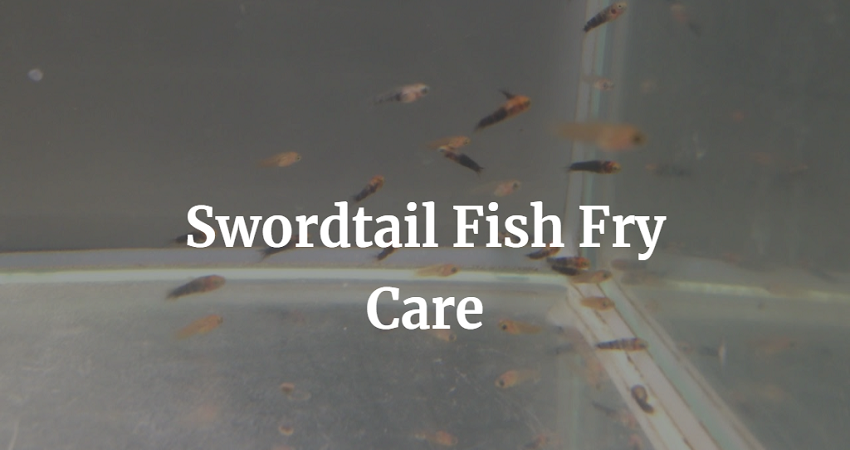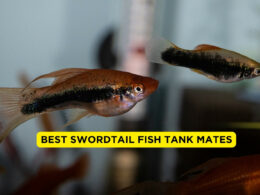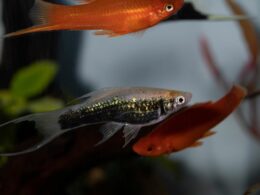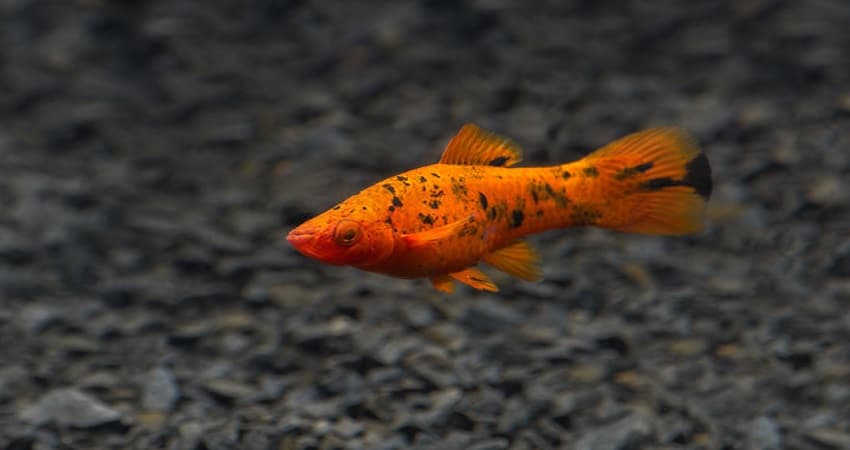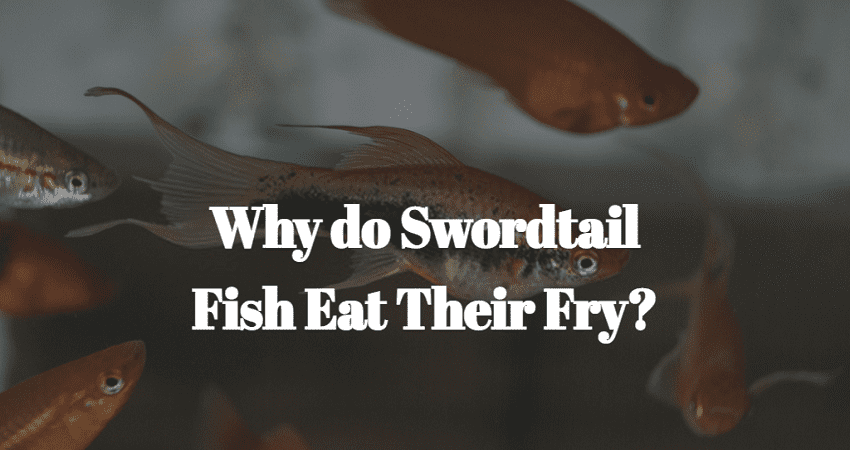In this article Show
When you don’t possess swordtail fish at an aquarium, you may believe there isn’t much to learn about them. One of my coworkers used to say that to me. He also informed me that the world of swordtails is full of unexpected incidents.
A female can shift into a male when still in her mid-life and devour babies, in addition to giving birth to roughly 80 infants at a time.
You might not believe it, but a swordtail can produce anywhere from 5 to 80 fry at a time. To ensure that all of the fries reach total growth, you must carefully care for them and keep them safe from adults.
Because the swordtail parents and other fish may consume the fry, you must separate the Swordtail fry in a separate tank. After separation, feed the nutritious fry diets such as baby brine shrimps, egg yolk, crushed flakes, and pellets.
Maintain identical water parameters to adult Swordtails by changing the water frequently.
How is Swordtail Fry Produced?
Any three-month-old swordtail is ready to reproduce. If you don’t want the swordtails to produce additional fry, you’ll have to separate the men and females, as they’ll mate if they’re left together.
The males have a sword-like anal fin, while the females have a fan-shaped anal fin. Identifying female or male swordtails is not tricky. You won’t need to do anything further to get your swordtails to reproduce other than combine the males and females in one tank.
The pregnancy will only last 28 days after the breeding. A female’s belly expands during pregnancy, and she develops a gravid patch near her anal fin.
Pregnant swordtails do not undergo mood swings, but you must maintain good tank conditions for their well-being. When the fish is ready to give birth, you must move it to a separate tank to give birth without difficulty.
Male swordtails provide the most significant harm to pregnant females because they might get hostile toward them, causing stress. Keep the swordtail out of a breeding box because there isn’t enough room for it to swim. It can potentially result in premature birth or even an abortion.
Some aquarists, particularly those at the primary level, have no idea what a pregnant swordtail looks like, making it difficult to remove it from the community tank on time. You should know what to search for to transfer yours on time.
It’s time to move your fish to a new tank if it stops eating, swimming, or slowing down. If the fish is pregnant, it may also sink to the bottom or stay in one place for an extended period. To keep the swordtail fry safe, relocate it to the communal aquarium tank after it pops the fry.
How Is The Swordtail Fry Being Saved
Swordtails and other livebearers devour their young most of the time. You can transfer the pregnant swordtail to a separate aquarium tank if you already have one in your home.
You can still save your fry if you don’t have one. The following are the measures to take:
- If you don’t have a breeding aquarium tank or a place for the pregnant swordtail to drop the fry, use a large plastic container or glass jar to keep your pregnant swordtail separate from the others.
When the female is ready to give birth, remove her from the communal tank and return immediately after the fry has popped. - You’ll need to purchase a breeding box to keep the female isolated from the fry after delivery. The box is a small mesh or plastic container that floats in your main aquarium tank.
One of the best features of the breeding box is that it eliminates any concerns about the aquarium’s water quality. The breeding box will have free-flowing water, but the fry will be locked inside for their safety. Remove the female from the breeding box as soon as she gives her enough room to swim. - Plants are added to the aquarium tank to give the fry more hiding places. Live plants such as hornworts, guppy grass, java moss, and water lettuce roots will help your swordtail fry survive.
The plants cover them for a few weeks until they’re big enough to start escaping from their parents. Aquarium accessories are used as well.
In four weeks, the fry will mature into a juvenile. The time varies significantly from one fry to the next, but if the water in your aquarium tank is in good condition, you should expect all of them to become juveniles within six weeks.
Adult swordtails may be aggressive against juveniles, although they are usually large enough to survive in the community tank. You’ll need to plant extra heavy greens to keep them safe. It will give them the necessary hiding spots to avoid harassment. Swordtail fry typically has a high survival rate when kept away from predators.
Feeding The Swordtail Fry
When they’re out in the wild, swordtails are omnivores. Insects, plants, invertebrates, and algae are among their favorite foods.
To stay healthy and multiply, you’ll need to feed them well-balanced food that closely resembles what they eat in the wild.
The low-quality feed is avoided because it can cause infections. Liquid fry and newly hatched brine shrimp are favorites of swordtail fry; avoid as much live meat and protein as possible.
Daphnia, mosquito larvae, and bloodworms are some other living meals. When choosing live feed, be cautious because infections might be transmitted to your swordtails.
Additionally, you can offer them tiny yolk pieces from boiled eggs. Begin by smashing the yolk into small pieces and placing them in your aquarium tank. To give enough vegetation for the infants, add extra living plants.
To add variety to their diet, feed them veggie supplements and crushed fish flakes. Swordtail fry consumes smaller meals and is served more frequently.
As a result, drop meals in modest amounts multiple times during the day. Don’t overfeed them; give them only as much food as they can consume in 3-5 minutes.
Maintenance Of The Swordtail Fry Tank
Most people say that swordtails are the best communal tank species they’ve ever seen.
Swordtails can reach a maximum size of 6 inches in their native habitats because they have ample space to do so.
Although the swordtails we buy in stores usually grow to be around 2.5 to 3.1 inches long, your tank size and water quality will significantly impact their size.
When kept in a breeding trap or a tiny aquarium-breeding tank, the swordtails develop slowly. You’ll need a separate massive tank for the swordtail fry to ensure appropriate growth.
The tank should be larger than your breeding trap but not as large as the communal aquarium tank. If your community aquarium tank is around 20 gallons, the baby swordtails will require a 10-gallon tank.
Swordtails, according to experts, are hardy fish. Although the sword is not functional, swordtails have a higher survival rate than any other livebearer.
That isn’t to say that poor water conditions won’t impact their development. Maintaining water conditions that differ from those recommended by experts will cause swordtail fry to grow more slowly.
Maintain a temperature of 64 to 83 degrees Fahrenheit and a pH of 7.0 to 8.3. The hardness of the water should be between 12 and 30 KH.
If the conditions are different, the swordtail fry will take over six months to reach full size. Furthermore, swordtails may not grow to their maximum size due to poor water conditions. Maintain appropriate water conditions for them to grow faster.
Read our other comprehensive article:
How Long Are Swordtail Fish Pregnant For?
Why Do Swordtail Fish Eat Their Fry?
Are Swordtail Fish Aggressive? All You Need To Know
When Does Swordtail Fry Begin To Consume Food?
Swordtail fry begins looking for food as soon as they are hatched. Finely disintegrated flakes and newly born brine shrimp are fed to them. If you wish to accelerate the growth of swordtail fish, feed them a high-protein, high-fat diet.
Vegetables, live or frozen food, and commercial flakes or pellets are all acceptable to swordtails. Feed them regularly and change the water frequently to raise healthy and beautiful fish.
Conclusion
To conclude, some people might think that the mother of the swordtail will take care of them, but this is different since some swordtail mothers eat the babies.
As soon as they are out of the water, newborns begin looking for nourishment. They can be fed brine shrimp that have just hatched and finely broken flakes.
Swordtail fry has a modest growth rate. Therefore, it is important to frequently change the water and feed plenty of meat if you want the swordtails to develop quickly. Finally, ensure that you take care of the baby’s swordtails for them to have a healthy life.






